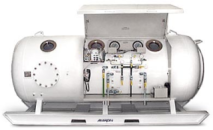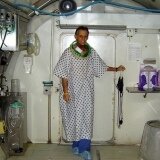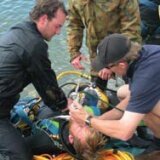Gas Gangrene
(Clostridial Myonecrosis), Clostridial Myositis And HBOT Treatment

Gas gangrene infection is severe and can advance quickly. Besides replicating and migrating, the organisms which cause gas gangrene produce poisons known as exotoxins. Exotoxins are capable of liquefying adjacent tissue and inhibiting local defense mechanisms which might normally contain a less virulent infection. As such, the advancing infection of gangrene may simply destroy healthy tissue in its path and spread over the course of hours.
The following information is re-produced by permission of UHMS
121.
©2008 Undersea and Hyperbaric Medical Society, Inc. The book can be purchased at
UHMS web site.
By Dirk J. Bakker, M.D.
For clostridial myositis and myonecrosis or spreading clostridial cellulitis with systemic toxicity (or a presumptive diagnosis of either) the preferred treatment is a combination of hyperbaric oxygen (HBO2), surgery, and antibiotics.
Clostridial Myonecrosis is either an endogenous infection, caused by contamination from a clostridial focus in the body (such as the bowel), or an exogenous infection, mostly in patients with compound and/or complicated fractures with extensive soft tissue injuries after street accidents.
The infection is caused by anaerobic, spore-forming, Gram-positive, encapsulated bacilli of the genus clostridium. More than 150 species of clostridium have been recognized but the most commonly isolated is C. perfringens(95%) either alone or in combination with other pathogenic clostridia, C. novyi (8%), C. septicum (4%), and C. histolyticum, C. fallax, and C. sordelli (1% or less of the infections).
A further subdivision can be made in clostridia that are toxogenic, i.e., C. perfringens, C. septicum, C. novyi, and clostridia that are believed to be only proteolytic, i.e., C. histolyticum, C. bifermentans, C. sporogenes, and C. fallax, which augment an infection by their proteolytic capabilities but do not cause the classical gas gangrene syndrome.
C. tertium, C. sphenoides, and C. sordelli can be considered as contaminants. It is not known if and what these microorganisms add to the disease process. The essential role of alpha-toxin in the pathogenesis of gas gangrene was confirmed by Williamson and Titball, who developed a genetically engineered vaccine against alpha-toxin. This vaccine proved to be of value in animal experiments.
Clostridium perfringens is not a strict anaerobe; it may grow freely in O2 tensions of up to 30mmHg and in a restricted manner in tensions up to 70mmHg.
The complete genome sequence of C. perfringens has been published recently.
The key to understanding the pathophysiology of gangrene is to approach it as a clinical concept, rather than a definitive bacteriologic or pathologic entity.
For the induction of Clostridial Myonecrosis, two conditions have to be fulfilled: 1) The presence of clostridial spores and 2) An area of lowered oxidation-reduction potential caused by circulatory failure in a local area or by extensive soft tissue damage and necrotic muscle tissue. This condition results in an area with a low O2 tension, where clostridial spores can develop into the vegetative form.121
The advantages of hyperbaric oxygen treatment in gas gangrene are two-fold. First, it may be life-saving because exotoxin production is rapidly halted and less heroic surgery may be needed in gravely ill patients. Second, it may be limb and tissue-saving, possibly preventing limb amputation that might otherwise be necessary.

Further Reading...
-
-
-
- Hyperbaric Oxygen Treatment : The Last Frontier. Philip B James MB ChB, PhD, DIH, FFOM
- Treatment of Diabetic Ulcer Wounds By Hyperbaric Oxygenation. Review Of Scientific Trials Concerning Diabetic Foot Ulcers
- Retinopathy of prematurity may be prevented by the intermittent use of higher dosages of oxygen.
- Hyperbaric Oxygen Treatment (HBOT): oxygen transport to ischemic / hypoxic tissues is explained in this article by analyzing the physics and physiology of oxygen.
- Why Hyperbaric Oxygen Therapy is the most natural way of letting the body to heal itself...
- Aerobic Cellular Respiration Overview...
- TRCS - Transportable Recompression Chamber System For Emergency Evacuation And Treatment.
- Acute Brain and Cardio-Respiratory Dysfunction After Blast/Blunt Injuries: The Life-Preserving Effects of Hyperbaric Oxygenation...
- Diseases of the Respiratory System.
- Oxygen Toxicity Overview
- Characteristics for Autism Spectrum Disorders and diagnostic criteria.
- Near Drowning Overview.
- HBOT: historical perspective and physical basis...
- Hypoxia is sometimes dangerous, life-threatening state for our cells and tissues. Learn about hypoxia symptoms, causes and types...
- SPECT - Single Photon Emission Computed Tomography Emission Computed Tomography, a type of nuclear imaging showing how blood flows to tissues of organs.
- Air Embolism, the definitive treatment of which remains Hyperbaric Oxygen Therapy (HBOT).
- Carbon Monoxide Poisoning, recovery among patients treated with Hyperbaric Oxygen appears to be improved beyond that expected with ambient pressure supplemental oxygen therapy...
- Cyanide poisoning in combination with carbon monoxide poisoning frequently occur simultaneously in victims of fires, smoke inhalation, military operations and industrial accidents.
- For Gas Gangrene (Clostridial Myonecrosis) and Clostridial Myositis or spreading clostridial cellulitis with systemic toxicity the preferred treatment is a combination of Hyperbaric Oxygen Therapy (HBOT), Surgery, and Antibiotics.
- Crush injury is directly associated with trauma while skeletal muscle compartment syndromes arise from ischemia, venous outflow obstruction, exertion, external compression as well as trauma.
- Hyperbaric Oxygen Treatment Center At Elisha & Rambam Hospitals
- With Compartment Syndrome, Hyperbaric Oxygen Therapy (HBOT) when used as an adjunct to a surgery and antibiotics shows promise as a way to decrease complications and morbidity.
- Decompression Sickness - definition, symptoms and treatment of choice...
- Non healing wounds like diabetic foot ulcers can benefit from HBOT.
- Exceptional Blood Loss Anemia and Hyperbaric Oxygen Therapy (HBOT) as adjunctive therapy to win the time for survaval...
- Subdural empyema and other intracranial or cerebral abscesses are usually caused by anaerobic bacteria (bacteria that function optimally in low oxygen concentrations)...
- Necrotizing wound infection may result from either a single strain or a mixed population of bacteria, typically occurring after trauma, surgery, and/or around foreign bodies...
- Refractory osteomyelitis is a chronic osteomyelitis which often does not responded to the treatment administrated. HBOT directly kills or inhibits the growth of infection also augmenting the efficacy of bacterial killing by antibiotics.
- Tissue necrosis, bone necrosis and other radiation injuries as a delayed complications of radiation exposure...
- Skin graft survive when oxygen and nutrients diffuse into them from the underlying wound bed...
- Thermal Burns: HBOT when used as an adjunct in a comprehensive program of burn care, can significantly improve morbidity and mortality, reduce length of hospital stay, and lessen the need for surgery.
- The appearance of early symptoms of autism is a reason to have a child evaluated by a professional specializing in Autism Spectrum Disorders. See the autism symptoms checklist...
- Several autism types have been defined along the autism spectrum, differing in the severity of the symptoms and total disability and in the combinations of autistic impairments with other disabilities.
- Autism And Vaccinations: Clear Answers & Smart Advice About Your Babys Shots
- Portable Hyperbaric Chambers and HBOT should become an important player in humanitarian efforts in support of casualties sustained by individuals from natural disasters, battlefields and terrorist acts...
- Portable Hyperbaric Chambers SOS Hyperlite
- In spite of a number of existing Autism treatments, there are no miracle autism cures. For many realistic parents striving to help their autistic kids to feel less frustrated, communicate, perform and feel better, one of the crucial questions is what is the correct course of the autism treatment?













